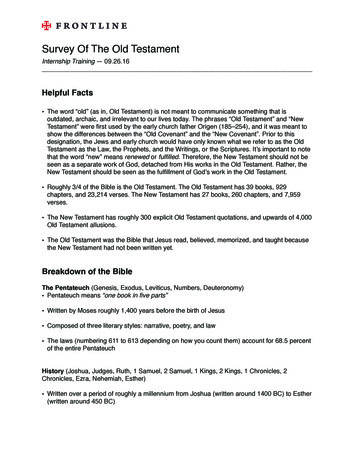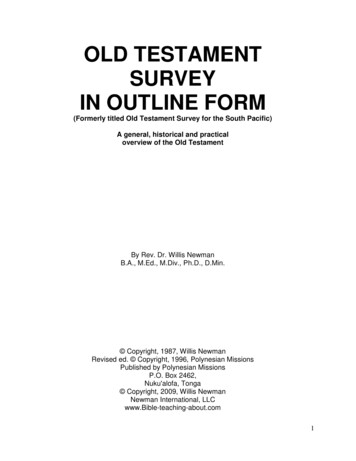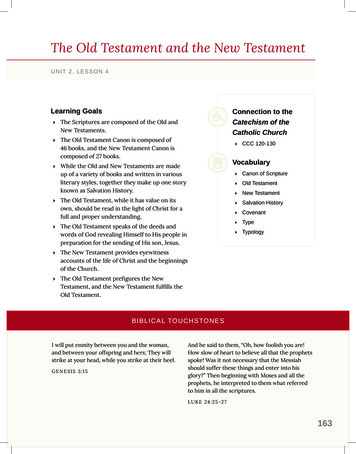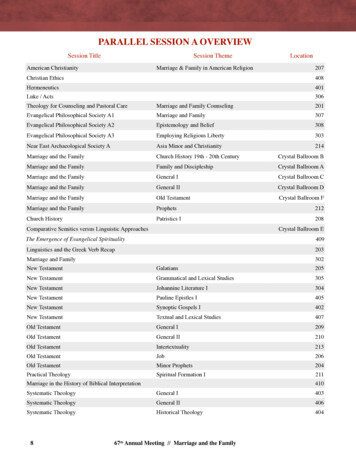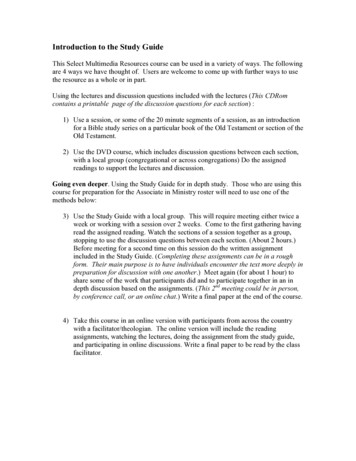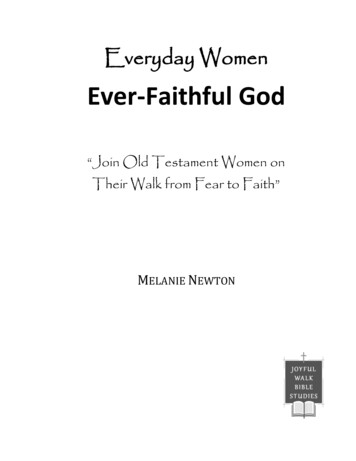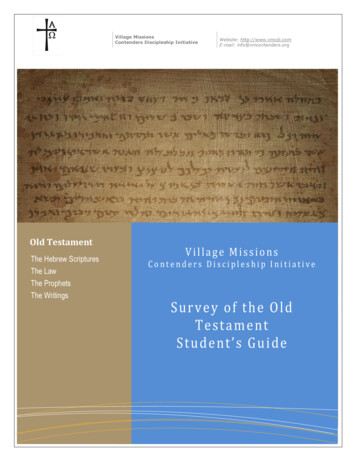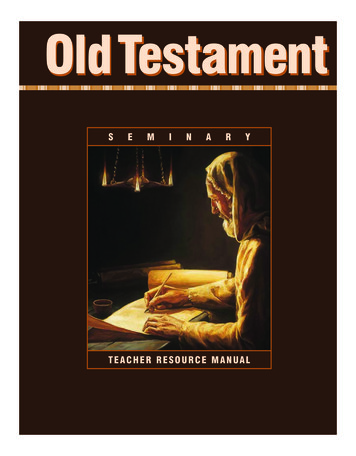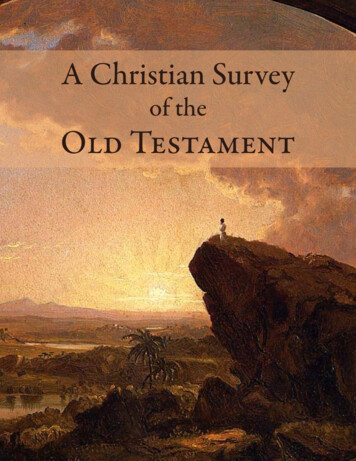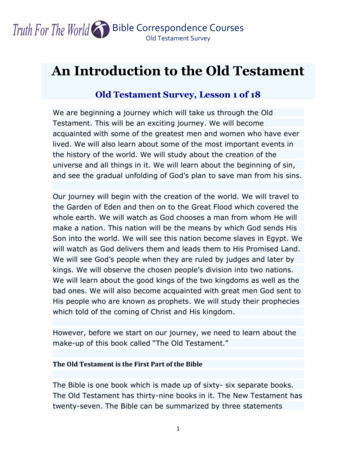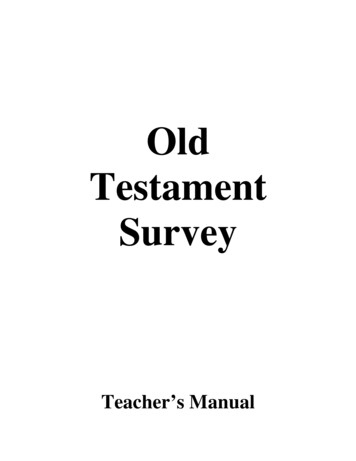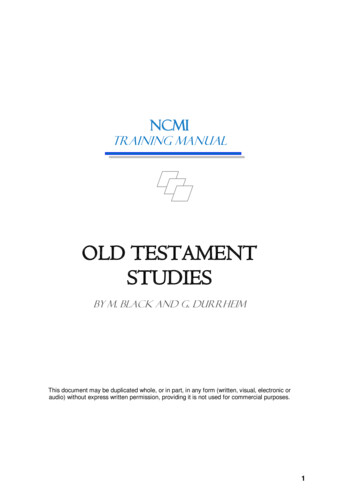
Transcription
NCMITRAINING MANUALOLD TESTAMENTSTUDIESBy M. Black and G. DurrheimThis document may be duplicated whole, or in part, in any form (written, visual, electronic oraudio) without express written permission, providing it is not used for commercial purposes.1
COURSE INTRODUCTIONWelcome to Old Testament Studies! We believe that your life is going tobe greatly enriched as you embark on this course. What you are about toembark upon is not a run-of-the-mill survey of the Bible. Although you willget a panoramic view of the Old Testament, our aim is to concentrate onsome of the major events and characters to give you a comprehensivegrasp of the message and historical flow of the Old Testament.The aim of this course is to help you: Appreciate the chronological flow of Biblical historyUnderstand how God reveals Himself progressively throughout theOld Testament, culminating in the advent of His Son, Jesus ChristSee God‘s plan of redemption and the role Israel plays in being Hischosen people for the display of His glory in the earthUnderstand the various types and shadows in the Old Testamentthat find their fulfilment in the person and work of Jesus ChristSee how apostolic Christianity has its beginnings in the OldTestament.Learn something of the apostolic heart through Abraham steppingout in faith and obedience to become the father of many nations,and how through him, ‗all the nations of the world will be blessed‘.See how the whole of God‘s revelation in both the Old and NewCovenants hold together to form a complete revelation of God‘splan for mankind.By studying sections of the New Testament we will show how aplatform of Biblical revelation is strengthened by having anunderstanding of the Old Testament.2
OutlineUnit 1 Introduction to Old Testament StudiesUnit 2 The Flow of Old Testament HistoryUnit 3 GenesisUnit 4 The ExodusUnit 5 JoshuaUnit 6 KingshipUnit 7 Prophets (Major and Minor)Unit 8 Amos and HoseaUnit 9 The Prophet IsaiahUnit 10 Habakkuk, Joel and JeremiahUnit 11DanielUnit 12 Ezra, Nehemiah, Haggai and MalachiConcluding SummaryAppendicesBibliography3
UNIT 1INTRODUCTION TO OLD TESTAMENT STUDIESOBJECTIVESBy the end of this unit you will: 1.Be given a panoramic overview of the scope of Old TestamentStudiesSee how the Old Testament points toward ChristSee the thread of God‘s ‗Apostolic heart‟ for theTHE OLD TESTAMENT AS HISTORY AND DRAMA―In beginning the study of a book it is well to take a forward glance over itsentire contents, as we look over the map of a country or district we areabout to explore, to get the lay of the land, or from a mountain-top to get asurvey of the entire horizon.‖ Dr. Pierson1.1The Life Story of IsraelThe story of the Old Testament spans four thousand years. It is akaleidoscope of dramatic activity as God gathers a people for Himself whowill be the instrument of declaring His purpose of redemption to the world.It is also the story of how God reveals Himself to the nations of the world.It is a book of profound encounters with God and His people. In all theseencounters, God progressively reveals who He is and what His plans arefor all mankind.It is not merely a history book, although it does take us through the historyof the Israelites. Neither must the Old Testament be seen in isolation fromthe New Testament. (We will be discussing that in a future study unit).You may know many of the outstanding stories of the Old Testament. Inthis study you will be able to place these stories in their context and seehow they are woven together to form a whole wonderful tapestry of ‗God‘sstory‘ and His dealings with His people, bringing them ever closer to afuller understanding of His call and purpose for all of mankind.The section below is an excerpt taken from Bernhard W. Anderson‘s book,―The Living World of the Old Testament‖. Take note of the flow of historyand drama in the Old Testament.4
The object of this exercise is to give you the gist of the flow of the Historyof the Israelites and hopefully begin to prepare a platform for your studiesof the Old Testament.―The most distinctive feature of the Jewish people is their sense of history.In many respects, the Jews have always been diverse - in theology, inculture, and even in racial characteristics. But Judaism is the religion of apeople who have a unique memory that reaches back through thecenturies to the stirring events of their Bible, events that formed them as apeople with a sense of identity and vocation. Whenever the Passover iscelebrated, whenever the Law is read in the synagogue, whenever aparent instructs his child in the tradition, this memory is kept alive. Indeed,if historical memory were destroyed, the Jewish community would soondissolve.The Christian faith may be expressed in many forms, but in the lastanalysis there is no substitute for retelling what Christians call ―the story ofour life‖ – that is, the history to which the Old and New Testaments bearwitness.‖ (Richard Niebuhr, The Meaning of Revelation).1.2 The Theatre of God‟s ActivityThe first eleven chapters of Genesis gives a biblical history.A brief summaryShortly after the turn of the second millennium B.C., Israel‘s ancestor,Abraham, migrated from Mesopotamia into the land of Canaan . Thepatriarchs, or founding fathers of Israel, moved about in the hill country ofCanaan, with Abraham, Isaac, and Jacob succeeding one another.Eventually, during a time of famine, Jacob‘s family migrated to Egypt.There, after enjoying initial favour, they were subjected to forced labour bythe Egyptian pharaoh. Under the leadership of Moses (about 1300 B.C.),however, and favoured by an extraordinary series of events, they escapedinto the desert, where they were forged into a community with a singlereligious allegiance.Leadership under JoshuaLater, under the leadership of Joshua, they successfully attacked Canaanand claimed the land as their own. During this time, they had to wageceaseless wars of defence. Enemy pressure became so intense that amonarchy was established under Saul, and in the time of kings David andSolomon (1000-922 B.C.) Canaan was an Israelite empire.On the death of Solomon, the United Kingdom split into the two kingdomsof north and south Israel (Ephraim and Judah). These kingdoms, by virtueof their strategic location in a buffer zone between Mesopotamia and5
Egypt, were drawn into the power struggle of the Near East. The NorthernKingdom fell under the aggression of Assyria (721 B.C.); and the SouthernKingdom, after more than a century of vassalage (subordination) toAssyria, fell victim to the Babylonians, who wrested world rule fromAssyria. Jerusalem fell to the Babylonians in 587 B.C. and the peoplewere carried away into Babylonian captivity.But under the benevolent rule of the next empire, Persia, the exiles werepermitted to return to their homeland, where they rebuilt Jerusalem andresumed their way of life. The restoration took place chiefly under theleadership of Nehemiah and Ezra (about 450-400 B.C.)Under Greek controlAfter more than two centuries of Persian rule, Palestine [Israel] camewithin the orbit of Greek control, as a result of the world conquest ofAlexander the Great (332 B.C.) Alexander‘s policy of imposing Hellenistic(Greek) cultural uniformity upon the world was continued by those whoinherited his divided empire, especially by the Seleucid rulers of Syria.When this policy was forced upon the Jewish community by a SeleucidKing, open revolution broke out under the leadership of the house of theMaccabees (168B.C.)But the Old Testament does not claim to be simply a book of secularhistory or culture. It is sacred history, to both Jews and Christians,because in these historical experiences, as interpreted by faith, theultimate meaning of human life is disclosed.From Israel‘s standpoint, this history is not just the ordinary story of wars,population movement, and cultural advance or decline. Rather, the uniquedimension of these historical experiences is the disclosure of God‘sactivity in events, the working out of his purpose in the career of Israel. It isthis faith that transfigures Israel‘s history and gives to the bible its peculiarclaim to be sacred scripture. To put it in a nutshell, the Old Testament isIsrael‘s witness to its encounter with God.For this reason, we cannot begin to understand the Old Testament so longas we regard it as merely great literature, interesting history, or thedevelopment of lofty ideas. The Old Testament is the narration of God‘saction: what He has done, is doing, and will do. All human history is thetheatre of this self-disclosure, and nature too is his handiwork; but He actsparticularly within the career of the comparatively obscure people in orderto initiate a historical drama that has changed human perspectives andhas altered the course of human affairs.‖I am sure you will agree that not only is this a wonderful concise outline ofthe Old Testament, but it describes powerfully the purpose of the OldTestament.6
Re-cap of some of the main points of this excerpt: It is sacred history, to both Jews and Christians, because inthese historical experiences, as interpreted by faith, theultimate meaning of human life is disclosedIt is the disclosure of God‟s activity in events, the working outof his purpose in the career of IsraelThe Old Testament is Israel‟s witness to its encounter withGod.The Old Testament is the narration of God‟s action: what He has done, what He is doing, and what He will do (in the future)The overall theme of the Bible is God the Father, preparing a bride for Hisson, Jesus. Marriage is a covenant and God relates to His people on thebasis of covenant.Read: Psalms 78, 105 & 106; Acts 7; Hebrews 11These all summarize something of the Old Testament story.2. SEEING THE OLD TESTAMENT THROUGH THE EYES OFJESUS―Then he said to them, "These are my words that I spoke to you while Iwas still with you, that everything written about me in the Law of Mosesand the Prophets and the Psalms must be fulfilled." (Luk 24:44)Three major divisions of the Hebrew Old Testament The Law (of Moses)The Prophets (Former and Latter)Writings (Poetical books, Five Rolls and Historical books)The Law commentates on God‘s dealings with His people. The Prophetsgive a heavenly perspective of what God is doing on earth. They interpretthe history because history cannot be understood by itself. We understandhistory because of what the prophets have said about history. So we can‘tjust read Kings alone. Reading the Prophets tells us what God is doing,and reading Kings tells us what is happening on the earth and what man isdoing. Chronicles is written at the time of the restoration after the Exile andlooks back over a period of about 500 years, starting with Saul and David.The chronicler is a preacher preaching his message. He takes from historyand draws out certain aspects to make his point. Psalms, on the other7
hand, is a theology book - the songs of theology - that expresses thetheme of what is happening prophetically and historically in the OldTestament.Bearing this in mind it would be helpful to see which Old Testamentscriptures Jesus and His disciples emphasised, because it is here that theApostolic gains perspective.Examples of Jesus’ use of the scripturesJesus was steeped in the scriptures and constantly quoted them in everyaspect of life: In His teaching; in His encounter with Satan in theWilderness; in His contact with the Scribes and the Pharisees; teachingthe disciples and prophesying about the future. It is therefore important tolook at the Old Testament through the eyes of Jesus.When Jesus was tempted by the devil in the desert, he quoted fromDeuteronomy (the Torah, the five books of Moses).Read Mat 4: 1 – 11 (cf Deut 8:3, 6:16, 6:13)Not only does Jesus reference the Old Testament and give it credence,but He also shows its greater fulfilment in Himself and the perfecting ofGod‘s purposes through the church.It is helpful to remember that at the age of twelve, Jesus was soconversant with the Scriptures that He held His own in debating anddiscussing it with the Jewish leaders in the Temple.Several of His statements regarding the Old Testament will help us in ourappreciation of the Old Testament.Alec Motyer cites five important assertions by Jesus regarding theOld Testament in the Gospel of Matthew 5:17-20 The Old Testament is ‗the Law and the Prophets‘ (vs. 17)Jesus is the ‗fulfilment of the Old Testament‘ (vs. 17b).The Old Testament has permanent validity for the earthlychurch (vs. 18).The Old Testament is to be obeyed by the children of theKingdom (vs. 19).It is crucial to assured citizenship (vs. 20).1A key moment in the life of Jesus took place in the Synagogue when Hewas given the scriptures to read. It says that ―He found the place where itis written‖ (which was Isaiah 61):1Alec Motyer – The Story of the Old Testament page 98
Is 61:18 ―The Spirit of the Lord is on me, because he has anointedme to preach good news to the poor. He has sent me to proclaimfreedom for the prisoners and recovery of sight for the blind, torelease the oppressed ‖ He then ends off by saying: ―Today thisscripture is fulfilled in your hearing.‖ (Luke 4:21).The key element here is Jesus‘ proclamation that in Him all the revelationof the Old Testament has come to fulfilment.3.THE OLD TESTAMENT POINTS TOWARDS CHRISTWe come now to probably one of the most important aspects of the OldTestament. The Old Testament is the progressive revelation of God toman, which culminates in the advent of Jesus Christ. By progressiverevelation we mean the unfolding disclosure of God to man. In otherwords, the ‗picture‘ of God and His ways moves toward a defining momentwhen we can see clearly all that God has planned for mankind.It is very much a two-way street. On the one hand it is looking forward tothe perfect revelation of God in Christ and then it is backward looking,confirming the process of God in the unfolding revelation of Himself.Alec Motyer states this principle very clearly:Hebrews 1.1 (NIV) offers a concise statement of God‘s revelation-plan.―In the past God spoke to our forefathers through the prophets at manytimes and in various ways‖ (Hebrews 1.1).He did not reveal all his truth at once but spoke polumeros, „in manyportions‟, spread (as we see in Scripture) over a two thousand year timespan.He also spoke polutropos, „in many ways‟ – in the recorded lives ofindividuals, and in Israel‘s history, through the spoken word, and the voiceof song.2In all the many and various ways, the unfolding, or disclosure, of God‘snature and ways was being revealed, moving toward the completion of Hisrevelation in Jesus Christ.The scripture continues:‖ but in these last days he has spoken to us by his Son, whom heappointed heir of all things, and through whom he made the universe‖.(Hebrews 1:2 – NIV)2Alec Motyer – The Story of the Old Testament page 179
This is the culmination of God’s full revelation in Christ.The Old Testament constantly points towards Christ our Messiah. Not onlyare there prophecies concerning the life and geography of Christ, e.g.Micah 5:2 concerning the birth place of the Messiah, or Isaiah 9:1-2concerning Jesus‘ ministry base in Galilee; but there are also greattheological themes that are only properly understood in the light of Christ‘satoning death on the cross and His subsequent resurrection and powerover death and sin, e.g. Habakkuk 2:4 ―the righteous will live by faith‖becomes Paul‘s great theme in Romans and Galatians (as well asHebrews). We want to follow these prophecies and themes through theOld Testament. These words of anticipation of God‘s great plan ofredemption is Christ the Redeemer and the Church as God‘sambassadors, those sent into all the world to share the good news with allnations (Genesis 12:3; Isaiah 49:6; Matthew 28:18).Although it is not in the scope of this section to do an exhaustive study ofhow the scriptures point toward the Messiah, we would like to show youhow the Old Testament points toward the New. Throughout this study youwill discover the types and shadows of Christ the Messiah in the writingsof the Old Testament.Here are some examples of the looking forward to Jesus the Messiah:3.1Old Testament Prophecies concerning Jesus Christ The Seed of the Woman victorious over Satan (Genesis 3:15- fulfilled in Galatians 4:4; Hebrews 2:11; 1 John 3: 8). War isproclaimed between Satan and the Seed of the woman, whereSatan shall bruise His heel, but the Seed shall bruise Satan'shead. Jesus suffered tremendously at the hands of men,crucifixion being an agonizing and slow death. But Jesus gainedthe ultimate victory.― because the devil has been sinning from the beginning. Thereason the Son of God appeared was to destroy the devil‘s work‖.(1 John 3:8). All families blessed through Christ, the Seed of Abraham(Genesis 12:3 - fulfilled in Acts 3:25; Galatians 3:8). Godpromises to make of Abraham a great nation, and that ALLfamilies of the earth will be blessed. Paul wrote to the Galatians,―The Scripture foresaw that God would justify the Gentiles byfaith, and announced the gospel in advance to Abraham: ‗Allnations will be blessed through you.‘‖ (Galatians 3:8)10
The priesthood of Jesus like Melchizedek (Genesis 14:18;Psalms 110:4 - fulfilled in Hebrews 7:1-28). We do not knowmuch about Melchizedek other than he was considered verygreat. He was the King of Salem (later to be Jerusalem) andpriest of the most high God. Salem means "peace," making himthe King of peace, and the writer of Hebrews also referred tohim as the King of righteousness. The patriarch Abraham paidhis tithes to Melchizedek, and Melchizedek blessed Abraham,bringing out bread and wine. It is fitting that he brought forthbread and wine, the elements Jesus used at His last supper.The beginning or ending of Melchizedek's life or his lineage isnot recorded, making him 3―without father or mother, withoutgenealogy, without beginning of days or end of life, like the Sonof God he remains a priest forever‖.(Hebrews 7:3) Jesus is the Passover Lamb (Exodus 12:1-14:46; fulfilled inJohn 19:31-36; 1 Corinthians 5:7; 1 Peter 1:19). To protectthemselves from the death angel, each family was to take aspotless male lamb, kill it, and then take the blood and place itupon the top and sides of the doorframe. When the angel sawthe blood, he would pass over the house. Peter said that wewere redeemed with the precious blood of Christ, as a lambwithout blemish and without spot.(1 Pet 1.19). Paul said ofChrist that He was our Passover which was sacrificed for us (1Cor 5.7). The Messiah's blood would be shed for our sins (Exodus24:8 - fulfilled in Hebrews 9:11-28). Moses took the blood andsprinkled it upon the people and the tabernacle and itsfurnishings. "Without the shedding of blood there is no remissionof sins," Hebrews 9:22 says. Neither by the blood of goats orcalves, but by His own blood Christ entered once in the HolyPlace to obtain eternal redemption for us. Jesus is the true bread from Heaven (Exodus 16:4 - fulfilled inJohn 6:31-35). God rained down manna from heaven which thepeople of Israel collected to make bread. Jesus reminded thepeople of this story, and said, ―I tell you the truth, it is not Moseswho has given you the bread from heaven, but it is my Fatherwho gives you the true bread from heaven. For the bread of Godis he who comes down from heaven and gives life to the world.‖Then Jesus declared, ―I am the bread of life. He who comes tome will never go hungry, and he who believes in me will neverbe thirsty‖. (John 6:32,35) Jesus the smitten Rock (Exodus 17:6 - fulfilled in 1Corinthians 10:1-4). The people of Israel complained againstMoses and God for they were thirsty. God then told Moses,11
―Strike the rock, and water will come out of it for the people todrink.‖ (Exodus 17:5). Paul said that they drank of the spiritualRock that followed them, and that Rock was Christ. Jesus saidthat those who drink of the water He gives will never thirst. Jesus to be lifted up on a cross (Numbers 21:8-9 - fulfilled inJohn 3:14-17). God sent a plague of snakes among the peopleof Israel as punishment for their continued complaining. Godcommanded Moses to place an image of a serpent on a pole. Ifsomeone was bitten, they would look upon the pole and besaved. It was a look of faith and not just a simple glance. Jesussaid that as Moses lifted up the serpent in the wilderness, somust the Son of man be lifted up, ―15 that everyone whobelieves in him may have eternal life‖ (John 3:14-17) Messiah will come out of Jacob (Numbers 24:17 - fulfilled inLuke 1:32-33; Revelation 22:16)."A Star shall rise out of Jacob, and a Sceptre shall rise out ofIsrael‖. The star would represent Jesus' glory and the sceptreHis authority and power. The angel told the Virgin Mary, "TheLord God shall give unto him the throne of his father David; andhe shall reign over the house of Jacob for ever; and of hiskingdom there shall be no end." Jesus said of Himself in John'sgreat vision, "I am the root and the offspring of David, and thebright and morning star." (Rev 22.16) God will send the Prophet (Deuteronomy 18:15-18 - fulfilled inJohn 6:14, 12:49-50; Acts 3:18-26). God promised He wouldraise up a Prophet from among Israel that will speak what Hecommands Him. When the people saw the miracle Jesusperformed in feeding the multitude with 5 loaves and 2 fish, theysaid of Him, "This is indeed the prophet who is to come into theworld." Jesus said that He spoke the words which the Fathergave to Him. Peter referenced Moses' prophecy of a comingProphet in his sermon about Jesus that he delivered in thetemple. (Acts 2.30; 3.22). Son of David raised from the dead (Psalms 16:8-11 - fulfilledin Acts 2:25-32; 13:35-37). When Jesus died, He went down intoHell and led away the captives and returned with the keys toHell and to death. David said, ―because you will not abandon meto the grave, nor will you let your Holy One see decay‖. (Psalm16:10). Peter quoted this passage in his Pentecost sermon andsaid that David spoke "of the resurrection of Christ, that his soulwas not left in hell, neither did his flesh see corruption." Paulalso quoted this same passage in his message in thesynagogue at Antioch. (Acts 2.31).12
The Messiah will come from Bethlehem (Micah 5:2 - fulfilledin Matthew 2:1-6). ‖But you, Bethlehem, in the land of Judah,are by no means least among the rulers of Judah; for out of youwill come a ruler who will be the shepherd of my people Israel.‖(Matthew 2:7). ―But you, Bethlehem Ephrathah, though you aresmall among the clans of Judah, out of you will come for me onewho will be ruler over Israel, whose origins are from of old, fromancient times.‖ (Micah 5:2). This was fulfilled when Joseph hadto take Mary to Bethlehem, the place of his birth, for the Romancensus.The great church father, St. Augustine, encapsulated the essence ofthis when he said:―The New is in the Old Concealed; the Old is in the New revealed‘. TheNew is in the Old contained; the Old is in the new explained‘. The New isin the Old enfolded; the Old is in the New unfolded‘. The New is in the Oldlatent; the Old is in the New patent‘. Attributed to St. Augustine4. SEEING THE OLD TESTAMENT THROUGH NEW TESTAMENTAPOSTOLIC EYES4.1God has a plan for all nationsBy looking at the Old Testament through New Testament ‗spectacles‘ wenotice that God has a plan for all nations—an apostolic plan. The NewTestament is not a new idea! Neither is it divorced from the Old. Rather, itis the fulfilment of the Old. Jesus said, ―Do not think that I have come toabolish the Law or the Prophets; I have not come to abolish them but tofulfil them‖. (MT 5:17).The Apostolic pattern finds its expression in the way the New Testamentapostles referenced the Old Testament. With this perspective in mind letslook at some of the Old Testament highlights that the New Testamentreferences.A key scripture referring to Genesis would be Galatians 3.8:―The Scripture foresaw that God would justify the Gentiles by faith, andannounced the gospel in advance to Abraham: ―All nations will beblessed through you.‖ (Galatians 3:8)The ‗apostolic eyes‘ saw Genesis 12 as the gospel in advance—thegospel for all nations. The gospel is not just the cross of Jesus. It is thefact that all nations will be drawn into God‘s plan of redemption. Aswonderful as the cross is, the cross without all nations takes you to theplace of Christ coming for only one nation. I.e. he has come to save theJews. That is not what He came to do. He came for all nations.13
Rom 1:16 ―For I am not ashamed of the gospel, for it is the power of Godfor salvation to everyone who believes, to the Jew first and also tothe Greek.‖The end goal of apostolic Christianity is to fulfil the great commission anddisciple every ethnic group in the earth, introducing them to God throughJesus Christ and bringing the Kingdom of God about. This is not a NewTestament phenomenon.Have a look at the following Old Testament scriptures that give anindication of God’s intention for the nations of the world:Isaiah says: ― the mountain of the Lord‘s temple will be established aschief among the mountains; it will be raised above the hills, and all nationswill stream to it.‖ (Is 2:2)―Their burnt offerings and sacrifices will be accepted on my altar;for my house will be called a house of prayer for all nations.‖(Is 56:7)Haggai says:―I will shake all nations, and the desired of all nations will come,and I will fill this house with glory,‘ says the LORD Almighty. 8 Thesilver is mine and the gold is mine,‘ declares the LORD Almighty. 9 The glory of this present house will be greater than the gloryof the former house,‘ says the LORD Almighty. And in this place Iwill grant peace,‘ declares the LORD Almighty.‖ (Hag 2:7-9)Jeremiah says:―At that time they will call Jerusalem the Throne of the LORD, andall nations will gather in Jerusalem to honour the name of theLORD”. (Jeremiah 3:17)Other important Scriptures to read: Is 14:26; 61:11; 66:18; Jer 3:17;33:9.This is the underlying theme throughout the Old Testament. God is movingtoward a time when this theme will find greater fulfilment in the earth.The Old Testament constantly points towards Christ our Messiah. Notonly are there prophecies concerning the life and geography of Christ, e.g.Micah 5:2 concerning the birth place of the Messiah, or Isaiah 9:1-2concerning Jesus‘ ministry base in Galilee; but there are also greattheological themes that are only properly understood in the light of Christ‘satoning death on the cross and His subsequent resurrection and power14
over death and sin, e.g. Habakkuk 2:4 ―the righteous will live by faith‖becomes Paul‘s great theme in Romans and Galatians (as well asHebrews). We want to follow these prophecies and themes through theOld Testament. These words of anticipation of God‘s great plan ofredemption is Christ the Redeemer and the Church as God‘sambassadors, those sent into all the world to share the good news with allnations (Genesis 12:3; Isaiah 49:6; Matthew 28:18). In other words, weare going to attempt to have an apostolic look at the Old Testament.We will investigate these prophecies and themes through the OldTestament. These words of anticipation of God‘s great plan of redemptionfind expression in Christ the Redeemer and the Church as God‘sambassadors who are sent into all the world to share the good news withall nations (Genesis 12:3; Isaiah 49:6; Matthew 28:18). In other words, wewill take an apostolic look at the Old Testament.CONCLUSIONWhilst one can get bogged down in the complexities of the Old Testament,we need to see that there are a number of golden threads of truth runningthroughout the Old Testament.Looking back to the Old Testament from a New Testament vantage point,one can see how it forms a cohesive whole, pointing toward the greaterfulfilment in Christ.We will now go on to discuss the flow of history in the Old Testament andintroduce you to the chronology of the Old Testament.15
UNIT 2THE FLOW OF THE OLD TESTAMENT HISTORYOBJECTIVESBy the end of this unit you will: Understand the chronological flow of the Old TestamentBe introduced to the key events and watershed moments in the historyof Old testament IsraelRecognise the unifying theme of the Old TestamentINTRODUCTIONOur plan is to look at the Old Testament chronologically and see the greatunfolding story of redemption. Having the New Testament gives us thewonderful benefit of hindsight.―A Chinese philosopher insisted on riding his mule backwards so that hewould not be distracted by where he was going and could instead reflecton where he had been. The Bible works in somewhat the same way. TheEpistles shed light backwards on the events of the Gospels, so that weunderstand them in a new way. Epistles and Gospels both shed lightbackward on the Old Testament‖. 3 [See the chart showing the tie-up ofthe old and new.]The object of a timeline or a chronological chart is to give you a frameworkwithin which to understand, in this case, the history of the Old Testament.As you get to know the timeline you will see the unfolding story of God andHis people and His purpose for all mankind. (We have given you a basicOld Testament timeline in Appendix I).By studying the events in their sequence gives us a better understandingof how God was at work in his pilgrim people, and how he was taking themon a journey of faith that would culminate in the coming of the Messiahand the unfolding of God‘s perfect plan of redemption. When you get togrips with the flow of history and God‘s activity in the life of His people, youwill note how the story moves to greater definition.1. AN UNDERSTANDING OF TIMEThe New Testament will throw some important light on understanding the3Philip Yancey. ―The Bible Jesus Read. Page 2416
concept of time. Although the New Testament has several words thatdescribe time, there are two in particular that are helpful in understandingtwo features of time.The Greek word chronos is used to
The Old Testament is Israel‟s witness to its encounter with God. The Old Testament is the narration of God‟s action: what He has done, what He is doing, and what He will do (in the future) The overall theme of the Bible
